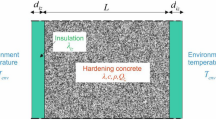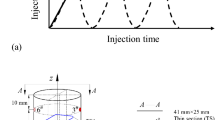Abstract
The knowledge of yield stress and plastic viscosity of cement-based materials is of special interest in various applications, including consolidation grouting, post-tensioning systems, and for numerical simulations. These rheological parameters are generally estimated from the shear stress-shear rate data using an empirical model. Highly pseudoplastic systems may not be adequately modeled using flow models typically used for conventional grouts. This paper summarizes the results of a study undertaken to evaluate the applicability of a number of analytical models to fit experimental data obtained on cement grout. In total, 44 grouts containing silica fume replacements of 1.5%, 3%, and 5% by mass of cementitious materials, blast furnace slag substitutions of 20% and 40%, and various combinations of high-range water-reducer and viscosity-enhancing admixture were evaluated. All mixtures were prepared with 0.40 water-cementitious material ratio.
Test results highlight the difficulties encountered when using conventional models to fit flow data of highly pseudoplastic mixtures of low yield stress. This is true for mixtures incorporating a viscosity-enhancing admixture, especially when combined with low dosage of high-range water-reducer. In general, the Herschel-Bulkley, Robertson, De Kee, and Casson models were found to be adequate for use with highly pseudoplastic grouts. A new model is proposed to provide better fitting of rheological profiles of highly flowable, yet stable, pseudoplastic mixtures that exhibit particularly low yield stress values.
Résumé
Les paramètres rhéologiques, soit le seuil de rigidité et la viscosité plastique, des suspensions de ciment sont des paramètres importants pour le contrôle de la qualité de ces matériaux. Ces paramètres sont génélement estimés à partir de la courbe d'écoulement en utilisant un modèle empirique. Les mélanges contenant un agent de viscosité montrent cependant un comportement pseudo-plastique largement plus important que les mélanges sans agent de viscosité. Les modèles empiriques utilisés pour simuler le comportement rhéologique des coulis ordinaires ne sont alors pas adéquats pour reproduire les courbes d'écoulement des coulis pseudo-plastiques. Dans cet article, on se propose d'évaluer la validité de différents modèles empiriques pour décrire le comportement rhéologique des coulis pseudo-plastiques. Quarante-quatre coulis contenant 1,5%, 3% et 5%, de la masse de liant, de la fumée de silice du laitier de haut fourneau à des dosages entre 20 et 40% et différentes combinaisons de superplastifiant et d'agent de viscosité ont été évalués.
Les résultats de cette étude ont montré qu'il est difficile de décrire le comportement rhéologique des coulis pseudo-plastiques en utilisant des modèles empiriques linéaires. En général, les modèles de Herschel-Bulkley, Robertson, De Kee et Casson sont adéquats pour décrire le comportement rhéologique des coulis pseudo-plastiques. En outre, un nouveau modèle non linéaire est proposé pour mieux décrire les rhéogrammes des coulis pseudo-plastiques ayant un faible seuil de rigidité.
Similar content being viewed by others
References
Lombardi G., ‘The role of cohesion in cement grouting of rock’, 15th Congress on Large Dams, International Commission on Large Dams, Q.58, R.13, Lausanne,3 (1985) 235–262.
Ghio, V.A., Monteiro, P.J.M. and Gjørv, O.E., ‘Effects of polysaccharide gums on fresh concrete properties’,ACI Materials Journal 91 (6) (1994) 602–606.
Ghio, V.A., Monteiro, P.J.M. and Demsetz, L.A., ‘The rheology of fresh cement paste containing polysaccharide gums’,Cement and Concrete Research 24 (2) (1994) 243–249.
Khayat, H.K., ‘Effects of antiwashout admixtures on fresh concrete properties’,ACI Material Journal 92 (2) (1995) 164–171.
Khayat, H.K. and Yahia, A., ‘Effect of welan gum-high-range water-reducer combinations on rheology of cement grout’,ACI Material Journal,94 (5) (1997) 365–372.
Tattershall, G.H. and Banfill, P.F.G., ‘The Rheology of Fresh concrete’, in ‘Pitman Advanced Publishing Program’, New York (1983).
Lapasin, R., Papo, A. and Rajgelj, S. ‘Flow behavior of fresh cement pastes, a comparison of different rheological instruments and techniques’,Cement and Concrete Research 13 (1983) 349–356.
Banfill, P.F.G. and Saunders, D.C., ‘On the viscometric examination of cement pastes’,Cement and Concrete Research 11 (3) (1981) 363–370.
Shaughnessy, R. and Clark, P.E., ‘The rheological behavior of fresh cement paste’,Cement and Concrete Research 18 (3) (1988) 327–341.
Vom Berg, W., ‘Influence of specific surface and concentration of solids upon the flow behavior of cement pastes’,Magazine of Concrete Research 31 (109) (1979) 211–216.
Jones, T.E.R. and Taylor S., ‘A mathematical model relating the flow curve of a cement paste to its Water/Cement ratio’,Magazine of Concrete Research 29 (101) (1977) 207–212.
Darby, R., ‘Viscoelsatic fluids: an introduction to their properties and behavior’,Chemical Processing and Engineering 9, New York: Dekker, C., 1976, 637 p.
Atzeni, C., Massida, C. and Sanna, U., ‘Comparison between rheological models for Portland cement pastes’,Cement and Concrete Research 15 (1985) 511–519.
Papo, A., ‘Rheological models for cement pastes’,Mater. Struct. 21 (1988) 41–46.
De Kee, D. and Chan Man Fong, C.F., ‘Rhelogical properties of structured fluids’Polym. and Engineering Science 34 (1994) 438 p.
Kantro, D.L., Influence of water reducing admixtures on properties of cement paste—A miniature slump test’,Cement, Concrete, and Aggregate, CCAGDP 2 (2) (1980) 95–102.
Khayat, H.K. and Yahia, A., ‘Simple field tests to characterize fluidity and washout resistance of structural cement grout’,Cement. Concrete and Aggregate 20 (1) (1998) 145–156.
Box, E.P., Hunter, W.G. and Hunter, J.S., ‘Statistics for experimenter: an introduction to design, data analysis, and model building’, Wiley Series in ‘Probability and Mathematical Statistics’, (1978) 653 p.
Baillargeon, G., ‘Probability, Statistics and Regression Techniques’, SMG Editions, (1989) 631 p (in French).
Author information
Authors and Affiliations
Rights and permissions
About this article
Cite this article
Yahia, A., Khayat, K.H. Applicability of rheological models to high-performance grouts containing supplementary cementitious materials and viscosity enhancing admixture. Mat. Struct. 36, 402–412 (2003). https://doi.org/10.1007/BF02481066
Received:
Accepted:
Issue Date:
DOI: https://doi.org/10.1007/BF02481066




